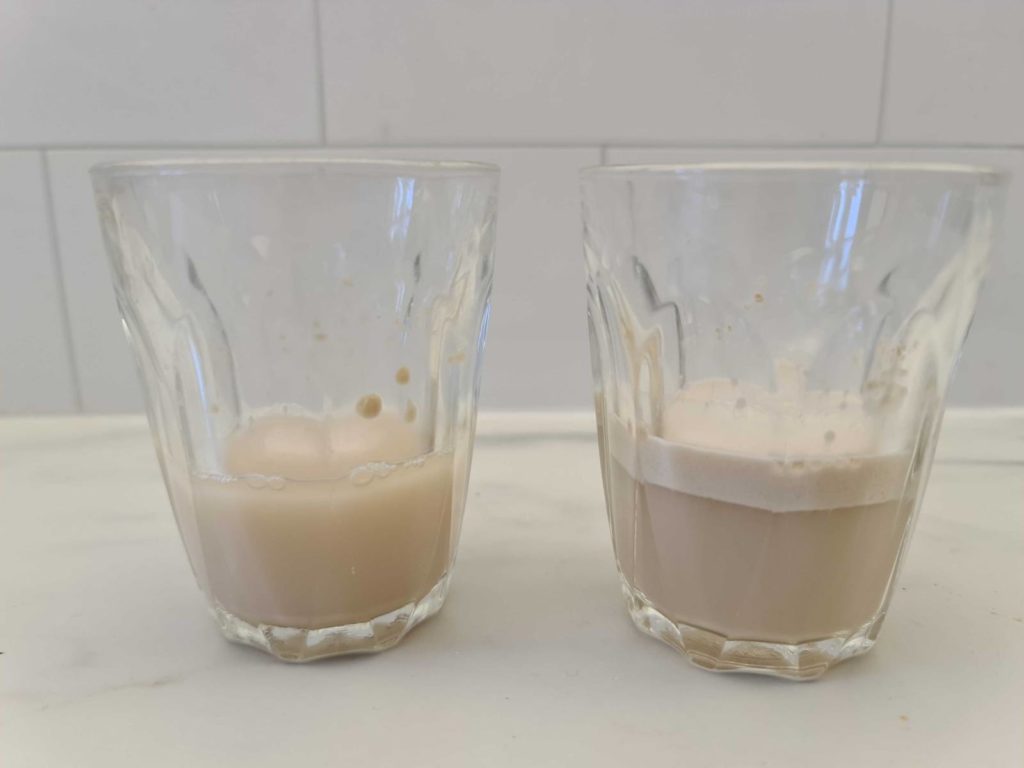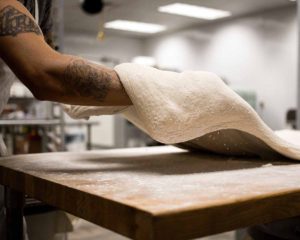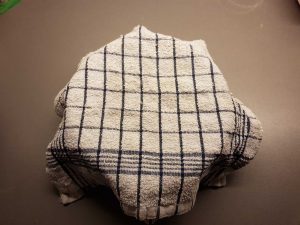A pizza dough that is not rising will make a dry, flat, pizza crust. Not what you’re usually looking for in a great pizza! This article will explain how rising pizza dough works, the top reasons why your pizza dough didn’t rise, and how you can easily fix it.
The top reasons your pizza dough is not rising are:
- Dead yeast – too old yeast or too hot water
- You’re raising the dough at a too-low temperature
- You’re using too little yeast
- You didn’t knead the dough enough
- The dough needs to rest longer
What causes pizza dough to rise?
Rising, or fermentation, is a complex process, and there are many factors that affect it. But in short, what makes your pizza dough rise, is yeast eating sugars from the flour, and converting it to CO2 that inflates the dough and makes it increase in volume. But to fully understand how this process works, let’s take a look at the 4 essential ingredients that make up any pizza dough.
The 4 essential ingredients for pizza dough
Every pizza dough consists of 4 ingredients: flour, water, salt, and yeast. And all of these play an important role in the rising of the dough.
Yeast
Yeast is a type of fungus that eats sugar. A byproduct of this is CO2 and alcohol. So when the yeast eats sugar, it turns it into CO2 and alcohol – this chemical process is called fermentation. The CO2 is what inflates the dough, and makes it increase in volume when it’s rising.
The yeast needs a certain temperature to work. When you bake pizza, the yeast likes to work at room temperature. If it’s hotter, the yeast will work faster, and if it’s colder, it will work slower. So the main way to manipulate how fast the dough is rising is to adjust the temperature or the amount of yeast. But there are also other factors that will affect the speed of fermentation, such as the hydration of the dough, the amount of salt, and the quality of the yeast.
Flour and gluten development
The main ingredient in pizza dough is flour. The flour is essentially food for the yeast. During fermentation, the flour is broken down into sugars that the yeast feeds on. If you want to feed your yeast good food, it’s therefore important to use quality pizza flour.
Read more about pizza flour here.
Water
Water allows the yeast to move more freely in the dough, and access its food (flour) faster. A higher hydration dough, therefore, allows the yeast to move even faster and will speed up the fermentation process, effectively decreasing rising time.
Higher hydration will make the dough rise faster, lower hydration will make the dough rise slower.
Salt slows down the yeast
In addition to enhancing flavor (have you ever tried any kind of bread without salt? … I don’t recommend it!), salt slows down the yeast. This means, that if you add more salt to your dough, it will take longer to rise, and if you add less salt, it will be quicker.
Read more about salt and how it affects dough and rising here.
Do you want your dough to rise fast?
This might sound like a silly question, but of course, you want pizza as fast as possible! Well… that’s not always the case. Fast-rise pizza dough might not create the best result. A slow-fermentation dough will have more flavor, better consistency, and be more digestible. And this takes time to develop.
So how fast your pizza dough should be rising depends on what kind of pizza you want to bake. That’s something you should keep in mind while reading this article.
As an example, for Neapolitan pizza, you want a long, slow rise, usually 8-24 hours. But to understand how different factors affect rising is useful to both slow down and speed up the fermentation depending on your goal.
Dead yeast
The most common reason for pizza dough that is not rising, is dead yeast. That can be a result of too hot water that kills the yeast, or that the yeast is old and not active anymore.
Too Hot Water
Yeast is a living microorganism that can die if it’s exposed to too-hot temperatures. The temperature yeast dies depends on the species, but most types of yeast will die at around 120-140°F (50-60°C). So if you mix the yeast with too hot water you’ll kill it, and as a result, your dough will not rise.
The Yeast Is Bad or Too Old
The yeast will also stop working if it’s too old. This is especially a problem with fresh yeast, which usually has a shelf-life of around 3 weeks. Dry yeast does last much longer, often 12 months, but it also goes bad if it gets too old.
How to check if the yeast is good
To check if your yeast is still active, fill a glass with warm water, 1 teaspoon of yeast, and 1 teaspoon of sugar (to give the yeast some food). Then leave it for 10-15 minutes. If the yeast is still active, it should start foaming.
In the picture below you can see what dead yeast (left) and healthy yeast (right) look like after 10 minutes.

Too cold water
If you use too cold water it will slow down the yeast. The yeast will start working as normal eventually, but not until the dough come to temperature. So if you start with cold water, it will take longer for the dough to rise than if you start with room temperature or lukewarm water.
One thing worth mentioning is that the temperature of the dough will increase when you knead the dough. So starting with water that’s on the cool side, might not be a bad idea. The AVPN (The True Neapolitan Pizza Association) recommends starting with 68°F (20°C) water when you bake Neapolitan pizza. The reason is that will let the dough reach the optimal rising temperature when you finish kneading.
Too cold rising temperature
Another reason your pizza dough is not rising is that the room you’re raising the dough is too cold. Lower temperatures will slow down the yeast. And even if you start with warm water, it will cool if you leave the dough to rise in a cold room.
Bad water
Bad water will mess with your yeast. The quality of tap water depends on your location. Hard water, pH, and added chemicals are factors that all affect fermentation time. If you’re unsure of the quality of your tap water, try bottled water.
Not enough yeast
The more yeast you add to the dough, the faster it will rise. So if don’t add enough yeast, the dough will rise too slowly, and can even appear to not rise at all.
How much yeast do you need for pizza dough?
How much yeast you need, mainly comes down to two things: how long you want your dough to rise, and at what temperature you rise the dough.
A typical Neapolitan pizza should rise for 8-24 hours and therefore need very little yeast. Because you want the process to be slow and steady. To achieve this slow rise, you typically use around 0.2% yeast (in baker percentages).
A typical homemade pizza, on the other hand, often has a rising time of 1-2 hours, and thus needs much more yeast than the Neapolitan-style pizza, because you need more yeast to make it rise that fast. This kind of pizza typically has around 3-5% yeast. I personally recommend trying a slow fermentation because the slow process adds a lot of flavors, but that’s a discussion for another time.
The amount of yeast you need also depends on the temperature you let the dough rise. So if your hose is colder than usual, you may have to increase the amount of yeast in the recipe. Similarly, if your hose is unusually hot, you may have to decrease the amount of yeast.
You didn’t knead the dough enough
Gluten development, which happens when you knead the dough is also important for the dough to rise. The reason is that when yeast turns sugar into CO2, the gas needs to be trapped for the dough to rise. That’s where gluten comes in.
Gluten is a type of protein found in wheat flour. When you hydrate and knead gluten, it will develop a strong network of gluten strands. This network will grow stronger the more you knead the dough. This network of small walls is what traps the CO2, and increases the volume of the dough. You can think of the dough as a balloon that the yeast is filling with gas when the dough is fermenting.
If you don’t knead the dough enough, the gluten network will not be strong enough to hold on to the gas. And the gas will just leak out as fast as the yeast can produce it. Imagine trying to inflate a balloon willed with holders – that’s not going to work very well.
It’s therefore important to knead the dough enough for the gluten to develop. This usually requires 15-20 minutes of kneading by hand.
Here’s a detailed article if you want to know more about gluten and how it affects your pizza dough.
Too short rising time
The least reason your dough didn’t rise, is that you didn’t give it enough time. Especially if you’re baking Neapolitan-style pizza, you have to be patient and give the dough the time it needs.
How to fix pizza dough that is not rising
Increase the temperature
The first thing to check if your dough is not rising is the temperature where it’s rising. You should aim for temperature, around 73-75°F (23-24°C).
How to increase the temperature
One thing you can do to increase the temperature is to place the dough in your oven with a cup of boiling water. The oven will trap the heat, and make a warmer environment for your dough.
Check that the yeast is working
When you’re baking Neapolitan-style pizza you typically don’t leave the yeast in lukewarm water to rehydrate, like in most bread recipes. It’s therefore a little harder to know if your yeast is working.
Dry yeast
To check if your dry yeast is still active, what you can do is to put a little bit of yeast in a glass of lukewarm water and leave a few minutes to see if starts to develop. You should be able to both see and smell the yeast after a few minutes. If the yeast is working, you can go ahead and make your pizza, the rest of these should be fine as well.
I personally use dry yeast all the time, because it’s very convenient due to the long shelf-life. The yeast I’m using the most is Caputo Lievito.
Fresh yeast
For fresh yeast, you can usually see and smell if it’s fresh or not. When the yeast gets old, the outside starts to dry out and sometimes gets a darker color. This is a sign that your yeast has gone bad, and it will not work properly if you try to bake with it.
Add more yeast to the pizza dough
If you think your dough contains too little yeast, you can dissolve yeast with a little bit of lukewarm water and mix it with the dough. If you suspect that the yeast isn’t working properly, I recommend checking it as described in the previous section.
Keep in mind that if you add more water to the dough, you might also want to add extra flour to not alter your hydration.
Knead the pizza dough more
To develop the gluten in the flour enough, you need to knead the dough for at least 15-20 minutes. So if you haven’t already done that, knead the dough more!
You can check for gluten development using The Poke Test or The Windowpane Test.
Give the Dough More Time to Rise
Don’t be impatient! If you’ve done everything above, give the dough more time to rise.
Baking in a different environment – why your pizza dough is not rising
One last thing worth mentioning is that baking in a different environment will hugely impact your dough and how how well it’s rising. Temperature, humidity, and altitude are some of the most common factors that will affect rising. So if you’re following a dough, and it doesn’t seem to give you the same result, it may be that you living in a different environment.
Temperature
In higher temperatures, the dough will rise faster, so if you live in a hot place, your dough will rise faster than in a cold place (unless you regulate the temperature using a heater or air conditioner, of course). If you’re baking in a hot environment, you, therefore, want to reduce the amount of yeast, and in a cold environment increase the amount of yeast in the dough.
Humidity
In a higher-humidity environment, the dough will rise faster. If you’re baking in a high-humidity environment, your dough will have higher hydration compared to the same recipe made in a low-humidity environment. The reason is that the dough will absorb water from the air, effectively increasing the hydration of the dough. As already mentioned, higher hydration will increase the rising time, while lower hydration will decrease the rising time. You therefore may have to adjust the hydration of your dough depending on the humidity by adding less or more water.
Altitude
High altitude will make the dough rise faster, due to the lower air pressure. At 3000 feet (900m), the dough can rise as much as 50% faster than at sea level. You, therefore, need to reduce the amount of yeast to mitigate this. At 3000 feet, you should reduce the amount of yeast by around 20%.
Traveling or Baking at New Locations
The above factors are something you should be especially aware of if you’re traveling, or recently moved.
I was once traveling to the mountains for skiing with some friends. And the pizza maniac I am, of course, I planned to bake pizza! But the dough didn’t seem to rise quite right… it was rising much faster than I expected, despite the cold, dry environment. And I couldn’t figure out why. This was the exact same recipe I had used a thousand times before. Honestly, I spent most of that weekend trying to understand what was going on and later understood that it was the low air pressure at the high latitude that made the yeast work faster.
Related
- Ooni Turning Peel Review: The Best Peel for Home - April 15, 2024
- Gi.Metal Turning Peel Review: Is This the Ultimate Pizza Tool? - April 14, 2024
- Discover Pizza Mastunicola: The Story of the First Pizza - April 7, 2024






Hi Andreas,
I live in Colorado at about 4800 feet above sea level. How does that affect the amount of yeast I should use?
Hi, I don’t have a lot of experience baking at high altitudes, but I would start by reducing the amount of yeast by 25% and see how it goes. You may also want to increase the hydration of your dough by adding a little more water to it. But i think you just have to experiment and make adjustments until you find out what works. Good luck!
Thank you for the tips. They are very helpful! Also, you might want to go through and fix about a zillion typos, and syntactical errors in your article.